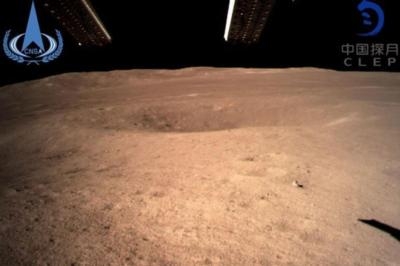Sat, Jan 05, 2019
Signals Maturity Of Chinese Space Program, Analysts Say
China has landed a spacecraft on the far side of the moon, the first time a lander has made a soft touchdown on that part of the body.

Ars Technica reports that, according to state-run media in China, the Chang'e-4 lander touched down early in the week in the Von Karman Crater in the South Pole-Aitken Basin. The region is in the mid-southern latitudes of the Moon on its far side.
Shortly after arrival, the lander sent back a photo of the lunar surface via its Queqiao relay satellite in lunar orbit. The lander carried a rover called Yutu II (Jade Rabbit II) which will collect high-resolution images of the surface, as well as study the surface and material just below the surface as well as the radiation environment on that side of the Moon.
The landing marks the first time a man-made object made a soft landing on the far side of the Moon. NASA Administrator Jim Bridenstine posted a message to the Chinese on Twitter shortly after announcement. "Congratulations to China’s Chang’e-4 team for what appears to be a successful landing on the far side of the Moon. This is a first for humanity and an impressive accomplishment!" he wrote.
China provided no live coverage of the landing. Many of the country's more difficult space efforts are only reported if they are successful, much in the same way the Soviets covered their space program in the 1960s.
The Washington Post reports that Alan Duffy, a lead scientist with the Royal Institution of Australia who focuses mainly on space exploration, called the landing a "clear statement about the level of maturity that China’s technology has now reached. Beijing’s longer-term goal to match U.S. capabilities could now become reality within two decades, and on the moon within perhaps only one decade."
China has publicly said it plans to land humans ... "Taikonauts" ... as early as 2030.
(Image released by the Chinese government)
More News
Pilot Also Reported That Due To A Fuel Leak, The Auxiliary Fuel Tanks Were Not Used On June 4, 2025, at 13:41 eastern daylight time, a Piper PA-23, N2109P, was substantially damage>[...]
Have A Story That NEEDS To Be Featured On Aero-News? Here’s How To Submit A Story To Our Team Some of the greatest new stories ANN has ever covered have been submitted by our>[...]
From 2023 (YouTube Edition): Reflections on War’s Collective Lessons and Cyclical Nature The exigencies of war ought be colorblind. Inane social-constructs the likes of racis>[...]
Aero Linx: Colorado Pilots Association (CPA) Colorado Pilots Association was incorporated as a Colorado Nonprofit Corporation in 1972. It is a statewide organization with over 700 >[...]
High Speed Taxiway A long radius taxiway designed and provided with lighting or marking to define the path of aircraft, traveling at high speed (up to 60 knots), from the runway ce>[...]
 NTSB Prelim: Piper PA-23
NTSB Prelim: Piper PA-23 ANN FAQ: Submit a News Story!
ANN FAQ: Submit a News Story! Classic Aero-TV: One Mans Vietnam
Classic Aero-TV: One Mans Vietnam ANN's Daily Aero-Linx (07.03.25)
ANN's Daily Aero-Linx (07.03.25) ANN's Daily Aero-Term (07.03.25): High Speed Taxiway
ANN's Daily Aero-Term (07.03.25): High Speed Taxiway



